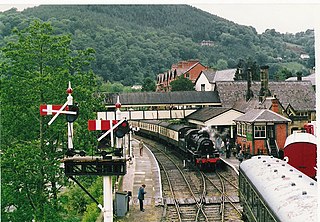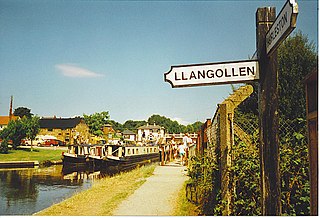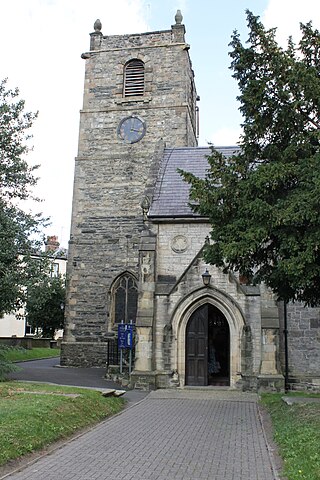
The "Ladies of Llangollen", Eleanor Butler (1739–1829) and Sarah Ponsonby (1755–1831), were two upper-class Irish women who lived together as a couple. Their relationship scandalised and fascinated their contemporaries. The pair moved to a Gothic house in Llangollen, North Wales, in 1780 after leaving Ireland to escape the social pressures of conventional marriages. Over the years, numerous distinguished visitors called upon them. Guests included Shelley, Wellington and Wordsworth, the latter of whom wrote a sonnet about them.

Llangollen is a town and community, situated on the River Dee, in Denbighshire, Wales. Its riverside location forms the edge of the Berwyn range, and the Dee Valley section of the Clwydian Range and Dee Valley Area of Outstanding Natural Beauty, with the easternmost point of the Dee Valley Way being within the town. It had a population of 3,658 at the 2011 census.

Historic Denbighshire is one of thirteen traditional counties in Wales, a vice-county and a former administrative county, which covers an area in north east Wales. It is a maritime county, bounded to the north by the Irish Sea, to the east by Flintshire, Cheshire and Shropshire, to the south by Montgomeryshire and Merionethshire, and to the west by Caernarfonshire.

The Llangollen Canal is a navigable canal crossing the border between England and Wales. The waterway links Llangollen in Denbighshire, north Wales, with Hurleston in south Cheshire, via the town of Ellesmere, Shropshire. The name, which was coined in the 1980s, is a modern designation for parts of the historic Ellesmere Canal and the Llangollen navigable feeder, both of which became part of the Shropshire Union Canals in 1846.

The Pontcysyllte Aqueduct is a navigable aqueduct that carries the Llangollen Canal across the River Dee in the Vale of Llangollen in northeast Wales.

The River Dee is a river in the United Kingdom. It has a total length of 113 km and is largely located in Wales. The stretch between Aldford and Chester is within England, and two other sections form the border between the two countries.

The Llangollen Railway is a volunteer-run heritage railway in Denbighshire, North Wales, which operates between Llangollen and Corwen. The standard gauge line, which is 10 miles (16 km) long, runs on part of the former Ruabon – Barmouth GWR route that closed in 1965. It operates daily services in the summer as well as weekends throughout the winter months, using a variety of mainly ex-GWR steam locomotives as well as several diesel engines and diesel multiple units. A 2+1⁄2 miles (4 km) extension of the railway has been built to complete the line to Corwen.

Chirk Aqueduct is a 70-foot (21 m) high and 710-foot (220 m) long navigable aqueduct that carries what is now the Llangollen Canal across the Ceiriog Valley near Chirk, on the England-Wales border, spanning the two countries.

Ruabon railway station is a combined rail and bus interchange serving Ruabon, Wrexham County Borough, Wales. It is the second busiest station in Wrexham County Borough in terms of passenger journeys, after the mainline station, Wrexham General. It is on the Shrewsbury to Chester Line, which is part of the former Great Western Railway mainline route from London Paddington to Birkenhead Woodside which lasted until 1967.

Upperville is a small unincorporated village in Fauquier County, Virginia, United States, along U.S. Route 50 fifty miles from downtown Washington, D.C., near the Loudoun County line. Founded in the 1790s along Pantherskin Creek, it was originally named Carrstown by first settler Josephus Carr. Through an 1819 Act passed by the Virginia General Assembly, the name was changed to Upperville.
The Ruabon–Barmouth line was a standard-gauge line owned by the Great Western Railway across the north of Wales which connected Ruabon, in the east, with Barmouth on the west coast.

Berwyn railway station in Denbighshire, Wales, is a railway station on the former cross-country line between Ruabon and Barmouth. The station, which opened in May 1865, was a stop on the Great Western Railway (GWR) line between Llangollen and Corwen. It remained open for almost a hundred years, and it was due to be closed to passengers on Monday 18 January 1965. However, it was closed prematurely due to flood damage on 14 December 1964.

Corwen railway station refers to two stations, on different sites, which have existed in the town of Corwen in Denbighshire, Wales.

Trevor is a village in Wrexham County Borough, Wales. It is situated in the scenic Vale of Llangollen, on the A539 between Llangollen and Wrexham, in the community of Llangollen Rural, and in the historic county of Denbighshire.

Valle Crucis Abbey is a Cistercian abbey located in Llantysilio in Denbighshire, Wales. More formally the Abbey Church of the Blessed Virgin Mary, Valle Crucis it is known in Welsh both as Abaty Glyn Egwestl and Abaty Glyn y Groes. The abbey was built in 1201 by Madog ap Gruffydd Maelor, Prince of Powys Fadog. Valle Crucis was dissolved in 1537 during the Dissolution of the Monasteries, and subsequently fell into serious disrepair. The building is now a ruin, though large parts of the original structure still survive. Valle Crucis Abbey is now under the care of Cadw. The abbey received 5,690 visitors in 2018.

The Llangollen Motor Museum is a small museum and autojumble source near Llangollen, Wales established in 1986.
Lloyd Williams and Underwood was a firm of architects based in Denbigh and active mostly in North Wales in the second half of the 19th century. The partners were Richard Lloyd Williams, formerly a pupil of Thomas Fulljames, and Martin Underwood, who was also county surveyor for Denbighshire. Several of their designed now have listed status.

St Collen's Church is a parish church in the town of Llangollen, Denbighshire, Wales. The first church on the site was founded by Collen in the 6th century. Nothing of this building remains. A new church was built in the 13th century, in the Early English Gothic style. This was developed in the succeeding centuries, and then almost completely rebuilt in the 19th century. The architect of the Victorian reconstruction was Samuel Pountney Smith, who retained little of the earlier church, with the exception of the tower. The churchyard contains the grave of the Ladies of Llangollen, Eleanor Charlotte Butler and Sarah Ponsonby, and their servant Mary Carryl, who lived at the nearby Plas Newydd. In November 2021 the first blessing of a gay partnership in a Church in Wales church was held at St Collen's. The church is an active parish church in the Diocese of St Asaph. It is designated by Cadw as a Grade I listed building.

Llangollen Town Hall, is a municipal building in Castle Street, Llangollen, Denbighshire, Wales. The structure, which is the meeting place of Llangollen Town Council, is a Grade II listed building.


















